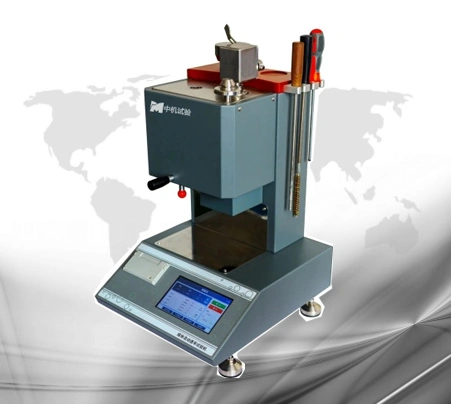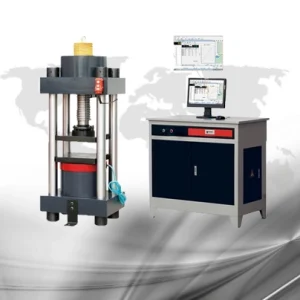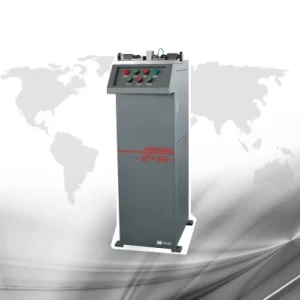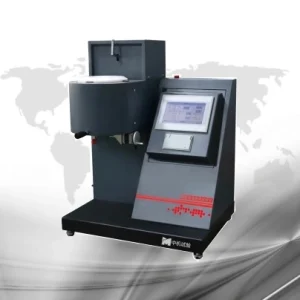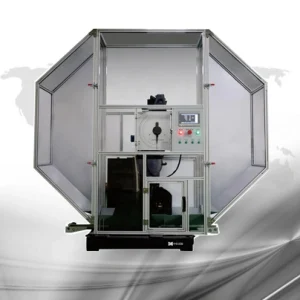DF82.300 New generation MFR testing machine
Features
- Goodappearance, stable and reliable performance;
- The furnace tube is made of purple copper, with low resistance and good thermal induction effect. Aluminum silicate cotton is used as insulation cotton between the furnace tube and the furnace chamber, which has a significant insulation effect;
- The inner wall of the barrel and the head of the piston rod are treated with Nitriding technology, which has high hardness and wear resistance;
- The feeding port adopts a seamless design, and the piston rod does not require a guide ring, resulting in smoother material pressing and less waste accumulation at the feeding port;
- The baffle of outlet port at the bottom of the furnace is designed to be semi closed, which facilitates the closure and removal of the outlet, and is more conducive to testing specimens with high melt index;
- The displacement sensor adopts a high-precision encoder, with a displacement acquisition accuracy of ± 0.005mm;
- The automatic cutting device consists of a drive circuit, an electric motor, and blades. Installed at the bottom of the material barrel, it has a compact size and flexible movement. It can be operated with jog, automatic cutting, adjustable force, and excellent cutting effect;
- The controller is a microcomputer controller specially developed by SINOTEST, which adopts a 7-inch high-definition touch screen display control, simple operation, and stable performance;
The weights are independent weights, convenient for viewing and taking, and easy to use.
Application fields
Widely used in factories, product quality inspection institutes, research institutions and other units for the production, inspection, development, research and other fields of plastics.
Standards
- GB/T3682-2018 “Determination of Melt Flow Rate and Melt Volume Flow Rate of Thermoplastic Plastics”
- ISO 1133:1997 “Determination of Mass Flow Rate (MFR) and Volume Flow Rate (MVR) of Thermoplastic Melts”
- ASTM D1238 “Standard Test Method for Determining the Melt Flow Rate of Thermoplastic Materials by Extrusion Plastimeter”
Testing method intro
Mass method and volume method: one machine for two purposes, Displayed through a 7-inch touchscreen controller, brand new interface:
Homepage interface
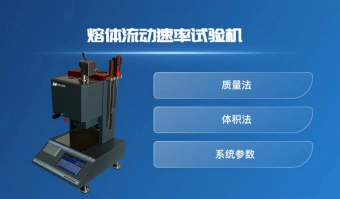
Function & Features
3.5.1 Comparison table
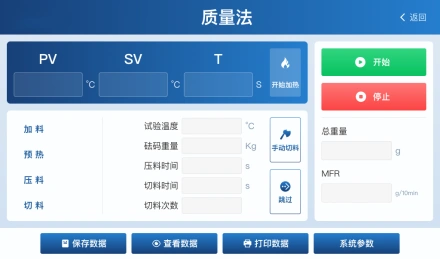
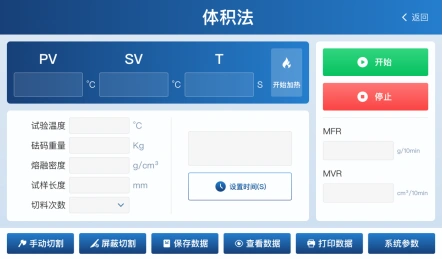
| No. | Item | New Gen. | Standard Ver. |
| 1 | L*W*H | 430×370×650 | 550×430×730 |
| 2 | Cut-off unit | Adjustable force, jogging mode, automatic cutting | Jogging mode, automatic cutting |
| 3 | Displacement sensor | 10000 line encoder | Photoelectric encoder |
| 4 | Displacement error | ≤ ±0.02mm | ≤ ±0.05mm |
| 5 | Weight | Independent weights | Combination weight |
| 6 | Controller | Touch screen | Push-button |
| 7 | Furnace temp– sensing position | Side | Bottom |
| 8 | Printing | MFR & MVR | MVR |
| 9 | Data storage | With | Without |
| 10 | MVR | Multiple cutting tests is OK | Only Single cutting test |
| 11 | Warm-up time | Adjustable | Set value |
| 12 | Displacement travel | Any input | 4 types for selection |
| 13 | Temp–correction | Multiple points | Single point |
| 14 | Furnace wire dia. | 60mm | 50mm |
| 15 | Temp–gradient | ≤ ±0.5℃ | ≤ ±1℃ |
| 16 | Heating type | Heating rod | Coil heating |
System setting
- The heating time and feeding time can be modified, making the experiment more flexible and convenient;
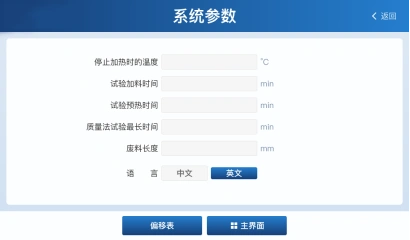
- It can perform multi-point temperature correction, making the temperature more accurate;
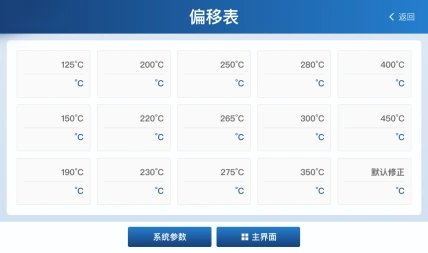
- ENG software language setting;
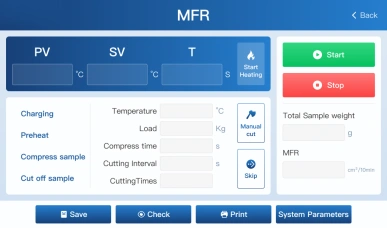
Volume method for testing
- The volume method can perform multi segment cutting, calculate the mean and values of each segment, and improve experimental efficiency;
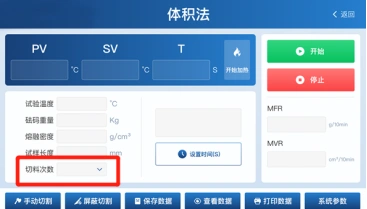
- specimencutting length: The appropriate stroke can be manually input based on the melting characteristics of the specimen, making the test plan more versatile;
- Shielding function: For specimens with high melt index, shielding can be selected to ensure more accurate time collection;
- The test time can be set and is no longer fixed at a constant value
Mass method for testing
- The mass method has calculation function, and the result can be obtained by filling in the mass;
- The experimental steps can be skipped according to different requirements.
Data storage and printing
Both the Mass method and the Volume method can be used for data storage, and can be repeatedly queried and printed, as shown in the following figure:
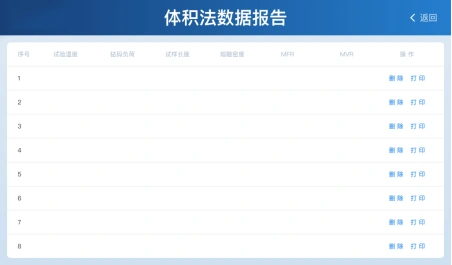
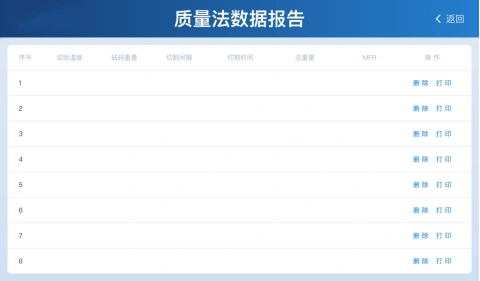
Main technical parameters
Temperature control
- Range: 100~450℃
The following commonly used temperature points have been calibrated at the factory: 125, 150, 190, 200, 220, 230, 250, 265, 275, 280, 300, 350, 400, 450 (℃);
- Fluctuation: ±0.2
- 4-hour drift: ≤ 0.5 ℃
- Distribution: ≤ 0.5 ℃
- Resolution: 0.1℃
- Error correction
Recovery time of specimen barrel temperature after feeding: ≤4 minutes
Pacer clock
- Range: 0~6000s;
- Resolution: 0.1s
Cut-off unit
- Automatic timed cutting
- Jogging cutting
- Manual cutting
Specimen outlet port inner diameter: Φ2.095±0.005mm
Specimen outlet port length: 8.000±0.025mm
Specimen barrel inner diameter: Φ9.550±0.020mm
Load:
- Accuracy: ≤± 0.5%
- Standard configuration load: 875g, 960g, 1200g, 1640g
- Weight accuracy: ± 0.5%
Data output type: Micro printer automatic printing output
Measurement range: 0.1~3000cm³/10min
Power supply: AC220V ±10%, 50HZ
Dimensions: L*B*H=430*370* 650mm
Weight: Approximately 30kg for the whole machine
Configuration
| No. | Item | Unit | Qty | Marks | |
| 1 | Machine host DF82.300 | pc | 1 | With micro printer | |
| 2 | Specimen rod component | set | 1 | ||
| 3 | 5kg independent weight | set | 1 | Within load: level 1 | |
| 4 | Accessory box | pc | 1 | ||
| 5 | Square Platen | pc | 1 | Stainless steel | |
| 6 | Piston rod | pc | 1 | ||
| 7 | Specimen outlet port | pc | 1 | Tungsten steel
(φ2.095) |
|
| 8 | Feeding unit | pc | 1 | ||
| 9 | Pressing rod | pc | 1 | ||
| 10 | Cleaning rod for specimen barrel | pc | 1 | ||
| 11 | Cleaning rod for outlet port | pc | 1 | Φ2 | |
| 12 | Specimen hopper | pc | 1 | ||
| 13 | Wooden handle cutting blade | pc | 1 | ||
| 14 | Blade (spare parts) | pc | 1 | ||
| 15 | Gauze | roll | 2 | ||
| 16 | Power cable | pc | 1 | ||
| 17 | Others | 1 copy each of documents, certificate, warranty card, and packing list | |||
